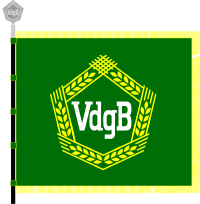Peasants Mutual Aid Association
Vereinigung der gegenseitigen Bauernhilfe | |
 | |
 | |
| Formation | 1945–1946 |
|---|---|
| Extinction | 1990–1994 |
| Headquarters | East Berlin |
| Location |
|
Membership | 640,000 |
Chairman | Otto Körting (1947–1950) Friedrich Wehmer (1950–1964) Ernst Wulf (1964–1979) Fritz Zeuner (1979–1982) Fritz Dallman (1982–1990) Karl Dämmrich (1990) |
The Peasants Mutual Aid Association (German: Vereinigung der gegenseitigen Bauernhilfe, VdgB) was an East German mass organization for peasants and farmers (later also gardeners.) It was founded in the 1945–1946 period and was a participant in the National Front. From 1950 to 1963 and again in 1986 it had representation in the Volkskammer.[1]
In 1989 a GDR publication put the membership of the VdgB at 632,000 persons.[2] During the Peaceful Revolution the VdgB suffered due to its extensive connections with the ruling Socialist Unity Party.[3] In February 1990 it changed its name to the Farmers Association of the GDR, but was unable to make the transition from East German society to that of a reunified Germany. It was fully liquidated in 1994.
From 1979 to 1990, the VdgB operated the Ringberghaus, a large hotel east of the city of Suhl. The hotel's purpose was to provide accommodation for farmers on holiday in the Thuringian Forest, and a VdgB voucher was required for lodging.
Chairmen of the VdgB
| Name | Term | Party |
|---|---|---|
| Otto Körting | November 1947 – March 1950 | SPD, SED |
| Friedrich Wehmer | March 1950 – February 1964 | SED |
| Ernst Wulf | March 1964 – October 1979 | SED |
| Fritz Zeuner | October 1979 – September 1982 | SED |
| Fritz Dallmann | September 1982 – March 1990 | SED |
| Karl Dämmrich | 1990 | SPD |
References
^ Gert-Joachim Glaessner. The Unification Process in Germany: From Dictatorship to Democracy. 1992. p. 33.
^ The German Democratic Republic. Berlin: Panorama DDR. 1989. p. 37.
^ Jonathan Osmond & Rachel Alsop. German Reunification: A Reference Guide and Commentary. 1992. p. 211.
External links
- Association for Mutual Farmers Assistance 1949–1990 (East Germany)